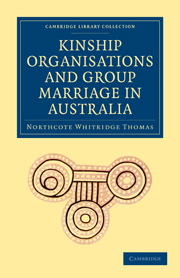Book contents
- Frontmatter
- PREFACE
- Contents
- BIBLIOGRAPHY
- INDEX TO ABBREVIATIONS
- CHAPTER I INTRODUCTORY
- CHAPTER II DESCENT
- CHAPTER III DEFINITIONS AND HISTORY
- CHAPTER IV TABLES OF CLASSES, PHRATRIES, ETC.
- CHAPTER V PHRATRY NAMES
- CHAPTER VI ORIGIN OF PHRATRIES
- CHAPTER VII CLASS NAMES
- CHAPTER VIII THEORIES OF THE ORIGIN OF CLASSES
- CHAPTER IX KINSHIP TERMS
- CHAPTER X TYPES OF SEXUAL UNIONS
- CHAPTER XI GROUP MARRIAGE AND MORGAN'S THEORIES
- CHAPTER XII GROUP MARRIAGE AND THE TERMS OF RELATIONSHIP
- CHAPTER XIII PIRRAURU
- CHAPTER XIV TEMPORARY UNIONS
- APPENDIX: ANOMALOUS MARRIAGES
- INDEX OF PHRATRY, BLOOD, AND CLASS NAMES
- INDEX OF SUBJECTS
- Plate section
CHAPTER VIII - THEORIES OF THE ORIGIN OF CLASSES
Published online by Cambridge University Press: 05 February 2012
- Frontmatter
- PREFACE
- Contents
- BIBLIOGRAPHY
- INDEX TO ABBREVIATIONS
- CHAPTER I INTRODUCTORY
- CHAPTER II DESCENT
- CHAPTER III DEFINITIONS AND HISTORY
- CHAPTER IV TABLES OF CLASSES, PHRATRIES, ETC.
- CHAPTER V PHRATRY NAMES
- CHAPTER VI ORIGIN OF PHRATRIES
- CHAPTER VII CLASS NAMES
- CHAPTER VIII THEORIES OF THE ORIGIN OF CLASSES
- CHAPTER IX KINSHIP TERMS
- CHAPTER X TYPES OF SEXUAL UNIONS
- CHAPTER XI GROUP MARRIAGE AND MORGAN'S THEORIES
- CHAPTER XII GROUP MARRIAGE AND THE TERMS OF RELATIONSHIP
- CHAPTER XIII PIRRAURU
- CHAPTER XIV TEMPORARY UNIONS
- APPENDIX: ANOMALOUS MARRIAGES
- INDEX OF PHRATRY, BLOOD, AND CLASS NAMES
- INDEX OF SUBJECTS
- Plate section
Summary
In dealing with the origin of the classes it is important to bear in mind that they are undoubtedly later than the phratries. This is clear, not only from the considerations urged on p. 71, but also from the fact that the areas covered by the same classes are in the three most important cases immensely larger than any covered by a phratriac system. We may therefore dismiss at the outset Herr Cunow's theory, which makes the classes the original form of organisation.
To explain the origin of the classes, as of the phratries, two kinds of theories have been put forward, which are in this case also classifiable as reformatory and developmental respectively. The former labour under the same disadvantages, so far as they assume that particular marriages were regarded as immoral or objectionable, as do the similar hypotheses of the origin of phratries.
What is the effect of dividing a phratry into two classes? Firstly and most obviously, to reduce by one half the number of women from whom a man may take his spouse. Secondarily, to put in the forbidden class both his mother's generation and his daughters' generation. It must however not be overlooked that it is the whole class of individuals that are thus put beyond his reach and not those only who stand to him in the relation of daughters in the European sense.
- Type
- Chapter
- Information
- Kinship Organisations and Group Marriage in Australia , pp. 86 - 92Publisher: Cambridge University PressPrint publication year: 2010First published in: 1906



